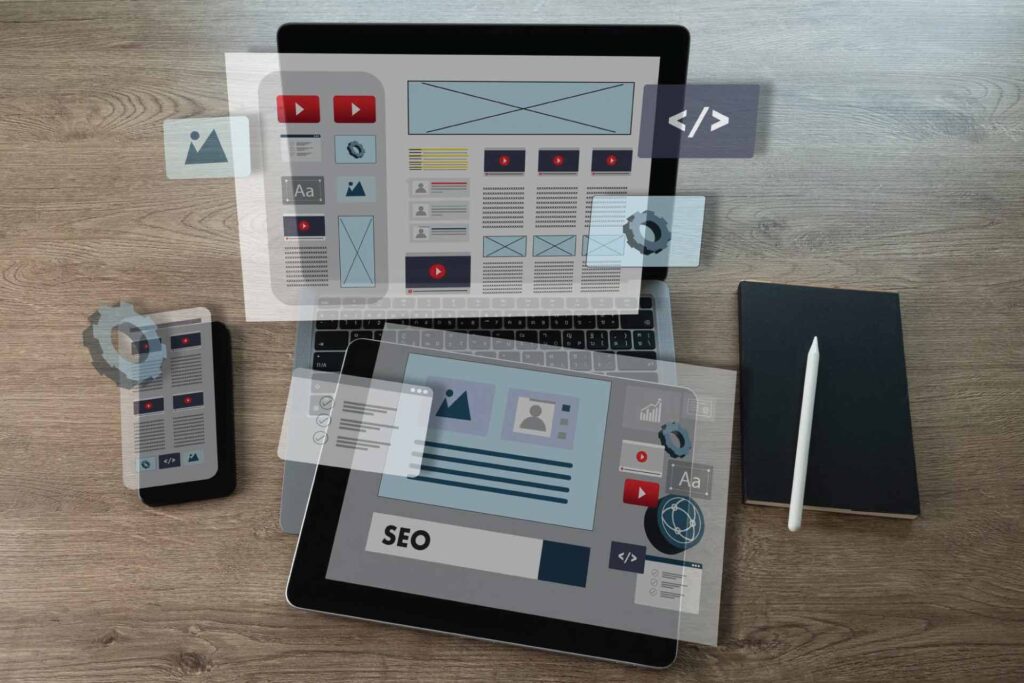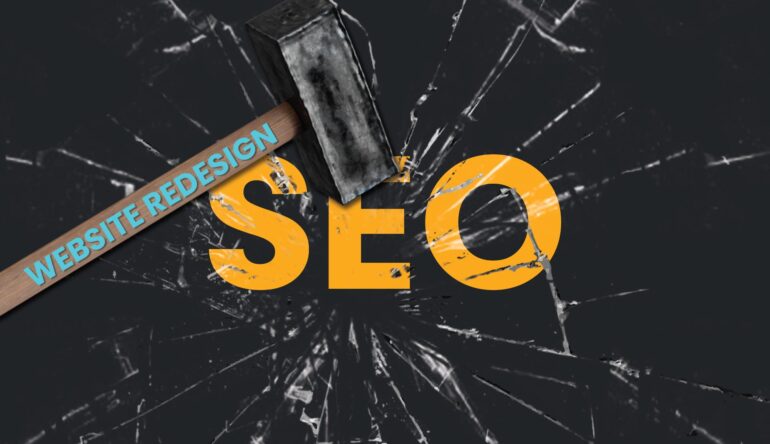There comes a time when a website feels and is outdated and needs a revamp. User experience and SEO performance suffer and the website performance could be better. This is when your website will benefit from a redesign.
Remember that this process will need careful planning and execution, to minimize the risks and maximize the gains.
In this blog post, we will cover all you need to know about choosing the right time for website redesign and how to do it right to not ruin your SEO in the process.
When Is It Time for a Website Redesign?
The first impression the audience has of your brand is your website. It is very important that the website continues to represent your business as time passes and ensure that it continues to meet user expectations and your business goals.

We made a list of key indicators that show that it might be the time for a website redesign:
- Outdated Design and Poor User Experience
- High Bounce Rate
- Lack of Mobile Optimization
- Difficulty in Updating Content
- Rebranding or Business Evolution
1. Outdated Design and Poor User Experience
To build trust and engagement, a website should be modern and have an aesthetically enjoyable design. If the opposite is true and it looks outdated and/or users cannot navigate it easily, you are likely losing potential customers.
Well-designed websites should:
- Clearly communicate the brand’s offer within the first few seconds.
- Have an intuitive navigation structure.
- Include modern visual elements and interactive features.
2. High Bounce Rate
A high bounce rate (above 40%) suggests that visitors leave your site without engaging further. This is not a good thing for a successful business online.
These are common reasons for a high bounce rate:
- Slow page loading times.
- Confusing or cluttered design.
- Poorly organized content.
Improving these elements can reduce bounce rates and improve conversions.
If this doesn’t help, this is one of the signs your website may need a website redesign.
3. Lack of Mobile Optimization
With over half of the internet traffic coming from mobile devices, having a mobile-friendly, responsive design is crucial for a successful business online.
Not only this, Google is using mobile-first indexing, which means that the mobile version of your website is stored in its index.

When a website is not optimized for mobile phones, users will leave your website fast, resulting in a high bounce rate and low user experience.
Since user experience is a ranking factor, a non-optimized website negatively affects your search rankings.
4. Difficulty in Updating Content
If adding or updating content is starting to become a burden, it can delay the success of your SEO efforts and slow down your ability to share new information.
To stop this from being a problem again, a website redesign should prioritize a user-friendly content management system (CMS).
5. Business Evolution or Rebranding
As your business grows, your website needs to reflect any branding updates or shifts in strategy.
An outdated brand representation can confuse or alienate your audience. This may slow down or completely prevent further growth of your business.
This is why website redesign is crucial in some stages of the online presence of your brand.
Steps to a Successful Website Redesign Without Harming SEO
Redesigning a website isn’t just about aesthetics, unfortunately, it often harms SEO instead of vice versa.

To be done right, it should include a strategic approach so that it can maintain and enhance the website’s search performance.
The results of a website redesign should be higher conversion rates, improved SEO, and digital marketing as a whole.
To not harm SEO during a website redesign you should do the following:
- Pre-migration Preparation
- Define objectives and Scope
- Make a redirection Strategy
- Be mindful of On-page SEO optimization
- Do technical SEO updates
- Post-Redesign Monitoring
1. Pre-Migration Preparation
Before you migrate your old website to the new, redesigned one you should do the following:
- A Complete Website Audit: Assess your current site to identify high-performing pages, underperforming content, and technical issues. This helps prioritize elements to retain or improve.
- Backup Everything: Ensure you have backups of all content, images, and graphics to prevent data loss.
- Set Benchmarks: Analyze metrics such as traffic, bounce rates, and keyword rankings. These will help measure the success of your redesign.
2. Define Objectives and Scope
Establish clear goals for the redesign, such as improving usability, increasing conversion rates, or enhancing SEO performance.
Outline the scope to manage timelines and budgets effectively.
3. Redirection Strategy
A redirection strategy is crucial in preserving the structure your website had before and avoiding duplicate content issues.
You should:
- Implement 301 Redirects: Redirect old URLs to their new counterparts to retain link equity and prevent 404 errors.
- Canonical Tags: Ensure canonical tags point to the preferred versions of pages to avoid duplicate content issues.
4. On-Page SEO Optimization
On-page optimization can be ruined during a website redesign. This is why you should be extra careful of the following:
- Meta Tags: Retain or optimize meta titles, descriptions, and headers for target keywords.
- Content Review: Update and optimize existing content, ensuring readability and SEO best practices.
- Internal Linking: Maintain or improve internal link structure to enhance navigation and crawlability.
5. Technical SEO Updates
After the new website has gone live you should do the following to ensure that all is working well:
- Robots.txt and XML Sitemap: Update these files and submit the new sitemap to Google Search Console.
- Test for Errors: Check for broken links, redirect chains, and loops that can hinder search engines and user navigation.
- Page Speed: Optimize for faster loading times by compressing images, enabling browser caching, and minimizing code.
6. Post-Redesign Monitoring
After all this is done and dusted you are left with post-redesign monitoring.
Do this so that you can stay on top of things and make sure that migration is completed successfully:
- Track Performance Metrics: Monitor traffic, bounce rates, keyword rankings, and conversion rates to measure the impact of the redesign.
- Fix Crawl Errors: Regularly check Google Search Console for any new issues.
- Update Backlinks: Inform external sites of new URLs to maintain referral traffic and authority.
Best Practices for an SEO-Friendly Redesign

For a website redesign to be crowned a success you should follow the following best practices:
- Content Prioritization: Focus on retaining high-performing content while updating or removing low-value pages. Content is a major driver of SEO success.
- User Testing: Do usability testing with real users to identify pain points and improve user experience before launching the new site.
- Responsive Design: Ensure the new website is fully responsive and provides a seamless experience across all devices and screen sizes.
- Analytics Setup: Set up analytics tools like Google Analytics and heatmaps to gather data on user behavior post-launch.
Case Studies: Successful Website Redesigns by W3Lab
Inspira Group Website Redesign
We transformed Inspira Group’s online presence in just 58 days, creating a unique website from scratch to align with their rebranding goals.
The new design introduced a fresh logotype and color scheme, combining innovative animations and visually striking elements.
Through close collaboration and efficient feedback loops, we successfully launched a future-oriented website that preserved Inspira Group’s market recognition while highlighting their evolution.
This redesign showcases the power of teamwork and creativity in delivering impactful digital solutions.
Results of the Inspira Group Website Redesign:
- A visually striking, future-oriented website aligned with their rebranding goals.
- Preservation of Inspira Group’s market recognition during the transition.
- Enhanced online presence, showcasing their evolution and leadership in the industry.
- 100% client satisfaction with design quality and timely delivery.
SEO Strategy Success for mts d.o.o.
In just three months, our team elevated the online visibility of mts d.o.o., Serbia’s No.1 telecom company, achieving remarkable growth in website traffic and user engagement through a revamped SEO strategy.
Solutions Implemented
We developed a comprehensive plan focusing on content creation, web development, and design enhancements, including:
- Optimized content for product listings and blog pages.
- Redesigning single product pages.
- Improved UX/UI with categorized content for better navigation.
- In-depth competition and trend analysis.
Results Achieved
- 30% Organic Traffic Growth: From 65,558 to 85,344 users.
- 54% Engaged Sessions Increase: Average session duration improved from 56 seconds to 1 minute 4 seconds.
- Improved Rankings: Achieved first-place rankings for competitive keywords like “mts iPhone 11 pro max 256 GB” and dominated keywords related to branded products and services.
Key Takeaway
Our targeted approach empowered mts d.o.o. to stand out in the competitive telecom sector, positioning them as an industry leader with measurable SEO success.
Final Thoughts
Website redesign is a powerful way to elevate your brand’s online presence.
By recognizing the right time for a redesign and following best practices, you can enhance user experience, maintain SEO performance, and achieve your business goals.
Careful planning, testing, and monitoring are key to a successful redesign that drives measurable results.





